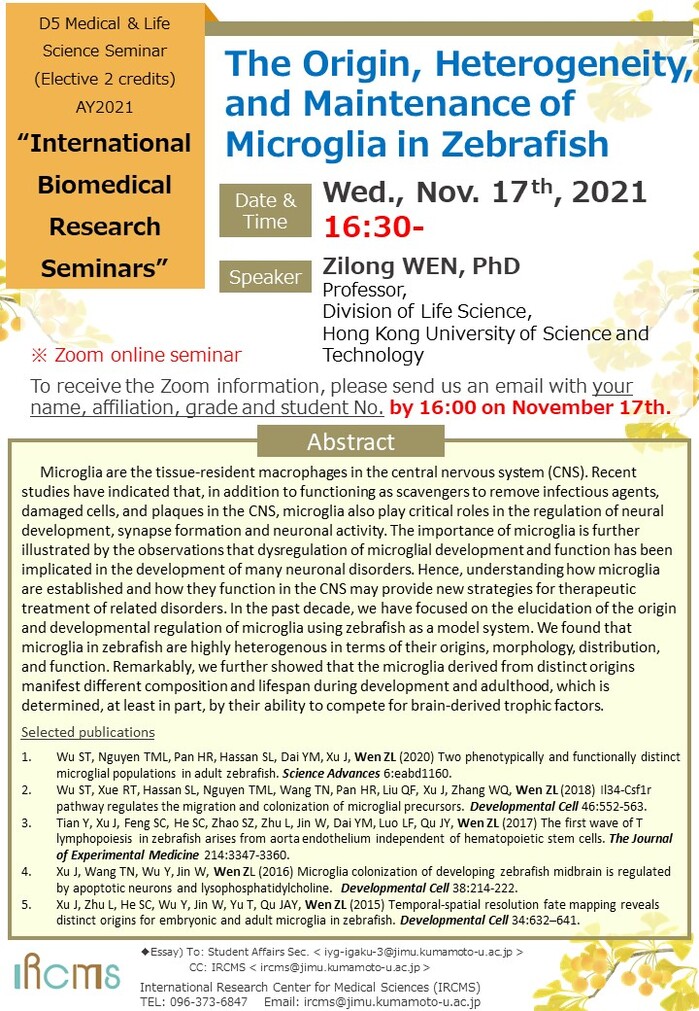- HOME
- News & Events
- [Nov. 17] D5 Medical & Life Science Seminar-Dr. Zilong Wen
News & Events
[Nov. 17] D5 Medical & Life Science Seminar-Dr. Zilong Wen
October 29 2021
The "D5 Medical & Life Science Seminar" course will be offered by International Research Center for Medical Sciences (IRCMS). It will run from April 2021 to March 2022, with lectures given by scientists who are affiliated with IRCMS or in collaboration with researchers at IRCMS. The lectures will be given once a month, in English, and by leading scientists in the relevant research field. Students will be taught: 1) how normal physiological functions are maintained in the human body; 2) how these systems become abnormal under certain pathophysiologic conditions; 3) why stem cells are important in animal development and homeostasis; 4) how stem cell-based approaches can help us understand disease mechanisms and find potential cure for diseases related to stem cell malfunction (e.g., cancer, aging).
Date : November 17, 2021 (Wednesday)
Time : 16:30 -
* Zoom online seminar
|
To receive the meeting ID / Password, please send an email to |
Speaker : Zilong Wen, PhD
Professor,
Division of Life Science,
Hong Kong University of Science and Technology
Title : The Origin, Heterogeneity, and Maintenance of Microglia in Zebrafish
Abstract :
Microglia are the tissue-resident macrophages in the central nervous system (CNS). Recent studies have indicated that, in addition to functioning as scavengers to remove infectious agents, damaged cells, and plaques in the CNS, microglia also play critical roles in the regulation of neural development, synapse formation and neuronal activity. The importance of microglia is further illustrated by the observations that dysregulation of microglial development and function has been implicated in the development of many neuronal disorders. Hence, understanding how microglia pools are established and how they function in the CNS may provide new strategies for therapeutic treatment of these neuronal disorders. In the past decade, we have been focusing on the elucidation of the origin and developmental regulation of microglia using zebrafish as a model system. We showed that zebrafish microglia are heterogenous in terms of their origins, morphology, distribution, development, and function. We further showed that the microglia of different origins manifest distinct composition and lifespan, which is determined, at least in part, by their ability to compete for brain-derived trophic factors.
Selected publications:
- Wu ST, Nguyen TML, Pan HR, Hassan SL, Dai YM, Xu J, Wen ZL (2020) Two phenotypically and functionally distinct microglial populations in adult zebrafish. Science Advances 6:eabd1160.
- Wu ST, Xue RT, Hassan SL, Nguyen TML, Wang TN, Pan HR, Liu QF, Xu J, Zhang WQ, Wen ZL (2018) Il34-Csf1r pathway regulates the migration and colonization of microglial precursors. Developmental Cell 46:552-563.
- Tian Y, Xu J, Feng SC, He SC, Zhao SZ, Zhu L, Jin W, Dai YM, Luo LF, Qu JY, Wen ZL (2017) The first wave of T lymphopoiesis in zebrafish arises from aorta endothelium independent of hematopoietic stem cells. The Journal of Experimental Medicine 214:3347-3360.
- Xu J, Wang TN, Wu Y, Jin W, Wen ZL (2016) Microglia colonization of developing zebrafish midbrain is regulated by apoptotic neurons and lysophosphatidylcholine. Developmental Cell 38:214-222.
- Xu J, Zhu L, He SC, Wu Y, Jin W, Yu T, Qu JAY, Wen ZL (2015) Temporal-spatial resolution fate mapping reveals distinct origins for embryonic and adult microglia in zebrafish. Developmental Cell 34:632-641.
Flyer: (Click for a larger image)

